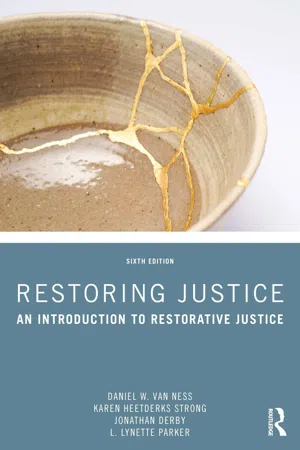
Restoring Justice
An Introduction to Restorative Justice
- 226 pages
- English
- ePUB (mobile friendly)
- Available on iOS & Android
Restoring Justice
An Introduction to Restorative Justice
About this book
Restoring Justice: An Introduction to Restorative Justice, Sixth Edition, offers a clear and convincing explanation of restorative justice, a movement within criminal justice with ongoing worldwide influence. The book explores the broad appeal of this vision and offers a brief history of its roots and development as an alternative to an impersonal justice system focused narrowly on the conviction and punishment of those who break the law. Instead, restorative justice emphasizes repairing the harm caused or revealed by criminal behavior, using cooperative processes that include all the stakeholders. The book presents the theory and principles of restorative justice, and discusses its four cornerpost ideas: Inclusion, Encounter, Repair, and Cohesion. Multiple models for how restorative justice may be incorporated into criminal justice are explored, and the book proposes an approach to assessing the extent to which programs or systems are actually restorative in practice. The authors also suggest six strategic objectives to significantly expand the use and reach of restorative justice and recommended tactics to make progress towards the acceptance and adoption of restorative programs and systems.
Frequently asked questions
- Essential is ideal for learners and professionals who enjoy exploring a wide range of subjects. Access the Essential Library with 800,000+ trusted titles and best-sellers across business, personal growth, and the humanities. Includes unlimited reading time and Standard Read Aloud voice.
- Complete: Perfect for advanced learners and researchers needing full, unrestricted access. Unlock 1.4M+ books across hundreds of subjects, including academic and specialized titles. The Complete Plan also includes advanced features like Premium Read Aloud and Research Assistant.
Please note we cannot support devices running on iOS 13 and Android 7 or earlier. Learn more about using the app.
Information
Part 1 THE CONCEPT OF RESTORATIVE JUSTICE
1 HOW PATTERNS OF THINKING CAN OBSTRUCT JUSTICE
- Patterns of thinking—their strengths and limitations
- An ancient pattern of thinking about justice: Justice is relational
- Historical shifts in thinking about crime
- Current pattern of thinking: Justice is impersonal
- Restorative Justice: An alternative pattern
Patterns of Thinking
If, as you stood waiting to cross the road, your brain had to try out all the incoming information in different combinations in order to recognize the traffic conditions, it would take you at least a month to cross the road. In fact, the changing conditions would make it impossible for you ever to cross.3
An Ancient Pattern: Justice Is Relational
Table of contents
- Cover
- Half Title Page
- Title Page
- Copyright Page
- Table of Contents
- Preface
- Acknowledgements
- Part 1: The Concept of Restorative Justice
- Part 2: The Cornerposts of Restorative Justice
- Part 3: The Challenges Facing Restorative Justice
- Index